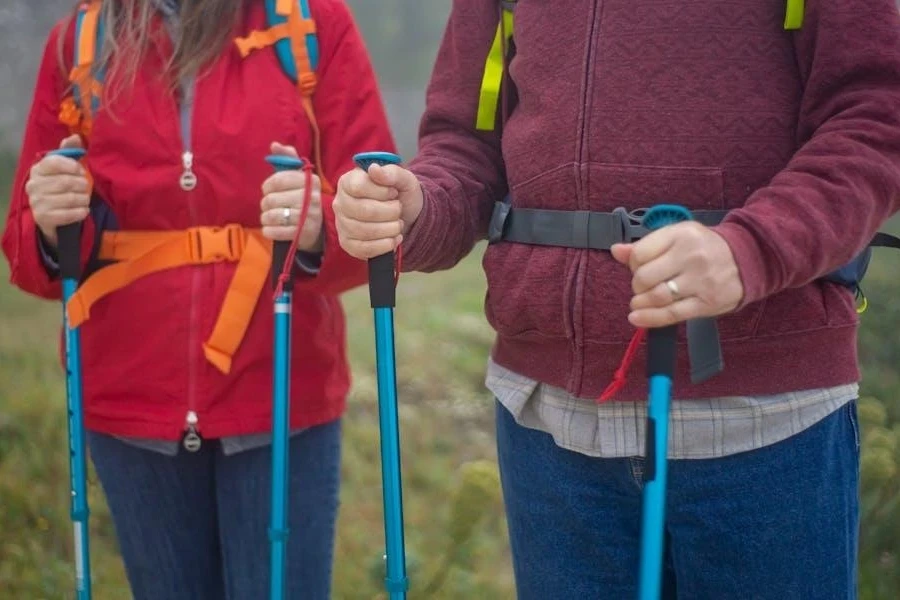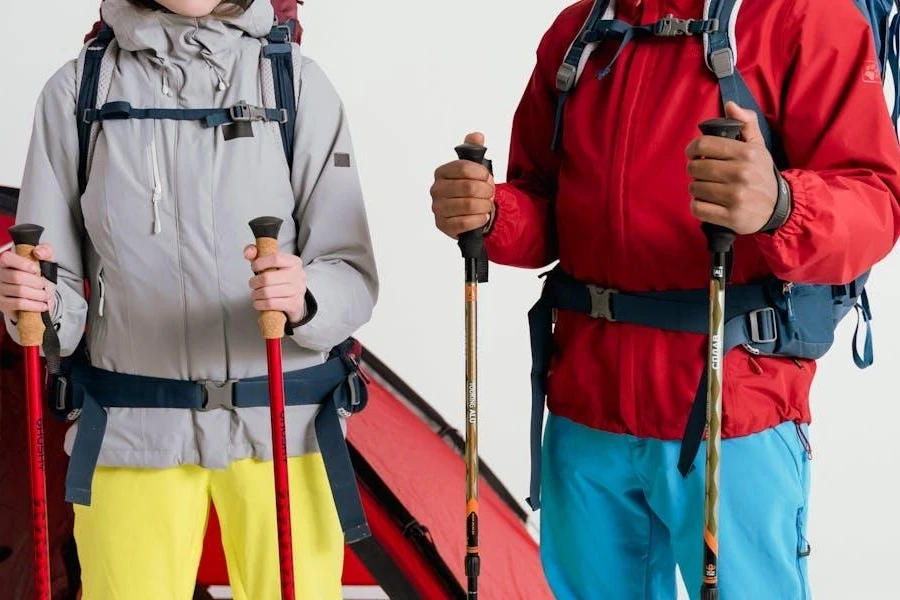Walking sticks (or trekking poles) weren’t always popular, especially with Americans. Many consumers saw these hiking aids as only necessary for the elderly or disabled. However, most hikers have changed their minds about trekking poles, allowing the product to skyrocket in popularity, especially in the 2020s. Walking sticks have evolved into the average hiker’s companion for tackling uphill and downhill challenges.
This article will explore why walking sticks are so popular and what business buyers should know before purchasing them. But first, check out the walking stick market’s stats.
Table of Contents
What’s the current value of the walking stick market?
Why are hikers using more walking sticks for their adventures?
5 main things to consider when choosing hiking walking sticks to sell in 2024
2 marketing strategies to help leverage the new demand for walking sticks
Final words
What’s the current value of the walking stick market?
The global walking stick market reached a valuation of US$0.75 billion in 2023. Experts say the market will hit US$1.41 billion by 2030 at a 5.2% compound annual growth rate (CAGR) over the 2024–2030 forecast period. More consumers are engaging in hiking, trekking, and backpacking, which has boosted demand for walking sticks.
The rising awareness of these outdoor activities is another growth driver for the walking stick market. According to the same report, consumers buy trekking poles primarily for hiking plains. North America also generated the most sales, as the region has a thriving outdoor recreation culture.
Why are hikers using more walking sticks for their adventures?

Four legs are better than two in the hiking world. That’s why many hikers now take walking sticks on their trips to make them more forgiving. Walking sticks provide two additional contact points with the ground, significantly enhancing balance and stability.
This extra stability hugely benefits hikers on uneven terrain, steep inclines, or slippery surfaces. And if they are carrying backpacks, walking sticks can help make the weight easier to bear. Even better, walking sticks can help distribute weight and reduce the impact on knees, hips, and ankles, meaning less fatigue and lower injury risks.
Walking sticks have generated more searches than they did last year. In 2023, they averaged 165,000 searches. But in 2024, they consistently raked in 201,000 searches monthly.
5 main things to consider when choosing hiking walking sticks to sell in 2024
1. Pole length

Pole length is one of the first things consumers will check when searching for walking sticks. The proper size will keep the user’s elbows at a 90-degree bend. Anything more (or less) than that would make walking uncomfortable. However, many models feature adjustable lengths, so offering the right option isn’t a big issue.
I. What to consider when stocking adjustable-length walking sticks
The consumer’s height is the major determining factor here. If they are taller than 6 feet, walking sticks with a 51-inch maximum length will make the best offer. But if they are shorter than six feet, they’ll use the adjustable features to make the sticks perfect for their size.
II. What to consider when stocking fixed-length walking sticks
Selling fixed-length walking sticks requires size charts so that consumers can determine what they need based on height. Businesses can follow the manufacturer’s guide or check the size chart below for more information.
| Height | Suggested pole length |
| Less than 5 ft. 1 in | 39 inches (100 cm) |
| 5 ft. 1 in to 5 ft. 7 in | 43 inches (110 cm) |
| 5 ft. 8 in to 5 ft. 11 in | 47 inches (120 cm) |
| 6 ft.+ | 51 inches (130 cm) |
2. Features

Sometimes, hiking involves a lot of extra activities. So, consumers may look for features depending on how they want to use their walking stick. Here’s a checklist of features to consider when stocking walking sticks.
I. Foldability
These walking sticks don’t become compact like adjustable variants. Instead, they closely resemble the folding mechanisms of tent poles. Foldable walking sticks are the easiest to pack for hiking trips. Plus, they are incredibly lightweight and easy to deploy, making them popular among fast hikers and ultrarunners.
II. Shock absorption
Walking downhill can hurt the joints, but these sticks have internal springs that soak up all that shock. The best part is that consumers can deactivate this feature when hiking uphill. Although shock-absorbing walking sticks are great for anyone, the primary target audience is outdoor activists with unstable hips, knees, or ankles—or those with previous joint injuries.
III. Weight
If consumers want to shed as much weight as possible, they won’t go wrong with ultralight walking sticks. These poles don’t have a lot of swing weight, making them easier to move. They are also easy to pack and won’t tire the user easily on long hikes.
IV. Camera mounting
Some walking sticks offer built-in camera mounts under the handle. For this reason, hikers can easily transform their sticks into a monopod to capture amazing scenery.
3. Locking mechanisms

Regardless of adjustability, all walking sticks have locking mechanisms to maintain their length. Non-adjustable walking sticks use this feature to extend to full length or collapse for storage. Similarly, adjustable sticks lock up when at the desired length. However, the locking mechanism lets users adjust the pole’s length (typically 24 to 55 inches). That aside, most options come with one of the following locking mechanism types:
- External lever lock: This lever-based mechanism makes adjusting walking sticks fast and easy, even when wearing gloves.
- Twist lock: This mechanism utilizes an expander and screw setup famed for extreme strength and durability.
- Push-button lock: These walking sticks snap into place and lock with one pull. However, hikers can push the button to unlock the pole and collapse it for storage. Most poles with this locking mechanism are non-adjustable.
- Combination lock: Some walking sticks combine different lock styles for the perfect balance of strength and ease of use. For instance, some variants may have twist locks on their lower shafts and an external lever on the upper one.
4. Shaft material

The walking stick’s shaft material is one factor that determines its overall weight. Manufacturers often make walking stick shafts from aluminum or composite. Aluminum shafts are incredibly durable and economical.
Usually, aluminum walking sticks weigh between 18 and 22 ounces per pair. Despite their high durability, these poles can bend and look disfigured. However, they won’t break like composite variants.
Composite variants are often partial or full carbon. They are lighter and more expensive, averaging between 12 and 18 ounces. Composite shafts can easily reduce vibrations but may break under high stress.
5. Grip

Walking stick grips feature various materials that determine how the product will feel in the hiker’s hands. One of the more common materials is cork. These grips are moisture-resistant, vibration-reducing, and conform easily to the user’s hands, making them perfect for hiking in hot weather.
The foam also absorbs moisture but comes with an added benefit. Foam grips are the softest options, making them the most comfortable. Lastly, rubber grips are great for insulation, shock, and vibration. They are the top picks for cold-weather activities.
2 marketing strategies to help leverage the new demand for walking sticks
Partner with hiking tour companies

Collaborate with hiking tour operators to offer walking sticks as part of their tour packages. This strategy provides an opportunity for potential customers to try the product in a real-world scenario and exposes the brand to a wider audience. Retailers can also offer a special discount to tour participants to incentivize purchases.
Host a “Walking Stick Challenge”

Organize a virtual or in-person walking challenge that encourages participants to track their steps, miles, or elevation gain while using walking sticks from the retailer’s store. This creates a fun and engaging way to promote the product, highlight its benefits, and foster a sense of camaraderie among hikers. Businesses should also offer prizes for reaching milestones or achieving specific goals, further incentivizing participation.
Final words
As hiking continues to surge in popularity, the humble walking stick has grown from a niche accessory to a must-have tool for outdoor enthusiasts. Its benefits for stability, joint support, and overall hiking experiences are undeniable, allowing the walking stick to become a mainstay in the hiking world.
By using this guide, retailers can tap into this growing market and provide hikers with the perfect companion for their adventures in 2024. Embrace this trend and equip customers with the tools they need to explore the great outdoors with confidence and comfort. Subscribe to the sports section on Chovm Reads for more insightful updates like this.




